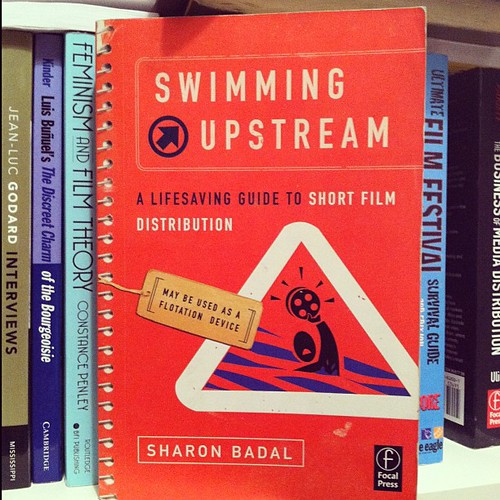5 Rad Things – Filmmaker Edition: Smartphone gadgets, world’s largest use-generated feature film and moooooar

figure from one of my altars
Happy Dia de los Muertos weekend! While many celebrate Halloween, I’m going to participate in another tradition and document examples of altars, sugar skulls and other spiritual artifacts. I’ll share the photos and some video next week.
In the spirit of filmmaking and film love in general, here are 5 Rad Things happening at the intersection of DIY, crowd-sourcing and low-budget awesome movie making.
Capta: Best $25 you’ll ever spend
Have you ever been at an event and kicked yourself for not bringing a second camera? Or, have you ever wanted to record yourself with your smartphone from a different angle but couldn’t pull it off without having Inspector go-go Gadget arms? Capta is a new device that I have invested in and am looking forward to experimenting with. From the team: “We set out to create a hybrid accessory for smart phones that would be elegant, functional and universal. Capta was primarily designed to be a tripod mount and has developed into an amazing hybrid accessory that allows you to do much more with your smart phones.”
Watch for yourself and dream of the possibilities, particularly with the impressive video quality on the iPhone 4S (captures full HD 1920×1080 footage, now with image stabilisation):
Check check check it out
If you go to their Kickstarter campaign and pledge at least $25 (the $20 pledge level sold out — hurry!), you’ll get one of these bad boys. For a $60 pledge, you will receive ONE exclusive Kickstarter black anodized Capta with green print and green pad, one multi purpose suction cup mount and one black PU multi-purpose sticky pad. AMAZING! Big thanks to Corvida for turning me on to this quite handy, low-cost product!
“Life In A Day”: The world’s largest user-generated feature film
Executive produced by Ridley Scott and directed by Kevin Macdonald, “Life In A Day” is a crowd-sourced documentary that uses footage uploaded by thousands of participants to YouTube’s campaign last year on July 24. Participants had 24 hours to submit.
You can watch it here. The director says the film was meant to be a “time capsule, which people in the future… could look back and say ‘Oh my God. That’s what it was like. A portrait of the world in a day.'” Below is a trailer explaining how it was done:
The film will be available as a DVD on November 8 in the U.S.
YouTube presented its first full-length film, “Four Eyed Monsters,” in 2007 which led the way for more platforms to release full-length feature films. People realized there was an appetite beyond the BitTorrent folks who have been sharing films since dial-up. so I think that this crowd-sourced YouTube documentary was a great opportunity for aspiring filmmakers to get exposure and participate on a project of this scale. However, it’s important to note the fine-print:
“As a contributor to the final film, you will be credited as a ‘co-director’ in the credits that appear at the end of the film. You will also be eligible for consideration to attend the film’s premiere at the 2011 Sundance Film Festival.”
That’s awesome. But the next part isn’t so awesome:
Will I get paid if my footage is used in the feature film?
“No, there is no monetary payment for contributing or being selected. However, you will be credited in the film.”
I’m sorry, that’s bogus. Google reported revenues of $8.44 billion for the quarter ended December 31, 2010. The LEAST they could have done (since this project makes THEM money through advertisers) is pay contributors who made the cut a small stipend. Would it have totally ruined Google financially to pay a few hundred people $300 each for their footage? I mean, we’re in a recession. Also, think about how much more the contributors would have helped to promote the film if they had a small stake in the ad revenue.
I think it’s telling that almost no one in my wide media circle is talking about this film. Neither are any of my filmmaker friends or film school friends. None of my 400+ friends on Facebook or almost 2,000 followers on Twitter have EVER said ANYTHING about “Life In A Day.” They honestly don’t give a crap. I care, because I love collaborative filmmaking projects, but not everyone is as geeky as I am. Google should have taken this into account and spent a fraction of their billions to pay contributors who would have certainly enthusiastically shared their glee with their networks, spilling into mine.
Collaborative project ‘99 Percent’ seeks filmmakers
Here’s a collaborative filmmaking project that I hope many get behind: “99 Percent: The Occupy Wall Street Collaborative Film” is a documentary film project founded by independent filmmakers working in conjunction across the country.The filmmakers are calling for others to join them in this project of documenting the Occupy Wall Street movement: anyone with footage, a camera, film skills or even just a desire to help is encouraged to get in touch.
Anyone who contributes footage will be paid a set fee per amount used in the documentary (GASP! Look, Google! The 99% get it! 😉 ).
The fee will be based on the budget the organizers are able to raise to fund the project. Footage will also go up on a community YouTube page for everyone to see.
All formats will be accepted. All points of view are welcome. All filmmakers and contributors will be credited. Right now the most current information (including a list of what is needed) is regularly updated on the Kickstarter page. Press requests and prospective participants can write to: contact@99percentfilm.com.
I don’t want to sound like a douchey marketing exec, but this project is SO ON BRAND with the Occupy movement. Collaborative. Democratic. And (key here, considering many of the accusations coming from Occupy critics) it’s practicing capitalism in a positive, realistic way! Their intention is to pay participants based on their budget. The Occupy movement isn’t anti-capitalism, although I know many folks who are involved are.
It takes many people with different opinions to affect change, but largely the Occupy supporters aren’t interested in destroying capitalism. The tools they are using to further the movement wouldn’t be possible without it (Macbooks streaming video, smartphones to share information, etc.).
Speaking of capitalism and initiatives that bring together commerce and social good: I still don’t understand why Google hasn’t made livestreaming available to everyone and currently limits it to their content partners. It’s elitist and driving their base to sites embracing collaborative media like Livestream. They are missing a huge opportunity to support social movements in an integral way — but it’s not too late. They can still turn things around, and I hope they do…
Distribution U. and “What’s the biggest challenge facing indie filmmakers?”
In case you missed this (I did), a group of 200 filmmakers converge on NYU’s Cantor Film Center last November for the first Distribution U. of 2010. The organizers posed We posed this question to their audience at a related workshop at UCLA. Here’s a screenshot of some of their responses:

You can view all the poll results on the CinemaTech blog.
Although the cost of filmmaking is certainly going down, most aspiring filmmakers are still splashing around hopelessly in the murky waters of film distribution. Artists are often given terrible deals, lose the rights to their own content, and other disappointing and financially devastating outcomes. Distribution U. is just one of many one day events where you can get a crash course on distribution, review case studies and ask experts questions in person. I highly recommend IFP for their assortment of conferences.
If you can’t afford to attend the conferences but can afford to buy a book, do yourself a favor and check out, borrow or buy the the 5th rad thing on this post….
Swimming Upstream: A lifesaving guide to short film distribution
Author Sharon Badal is a short film programmer of the Tribeca Film Festival. Jane Rosenthal, the co-founder of the fest, sums her book up better than I ever could:
“If you are a filmmaker with an interest in making short films, you need to read “Swimming Upstream.” With refreshing candor, Sharon Badal has written a unique book that is a wealth of information and true-life inspiration.”

I will go one step further and say that this book should be required reading in every film program at every university, community college and high school. Much of the knowledge in this book can be applied to feature-length film distribution and there are insights into the festival programming process that are invaluable — coming straight from someone who lives and breathes programming.
Also, read this op-ed piece by filmmaker Jennifer Fox (I interned for her in 2004 and 2005) on her film “My Reincarnation” and the changing model of film distribution. She’s had films air on PBS and released theatrically but struggled for years to get her latest film made. Thankfully, she was able to get the funds she needed through Kickstarter:
“Our Kickstarter campaign completed at the end of May 2011 and we ended up, amazingly, raising $154,000. We broke all the Kickstarter records. We are the highest raising Kickstarter campaign ever for a finished film. We’re the second highest raising documentary of all time and we’re the fifth highest raising film, fiction or documentary. We also happen to be the ninth highest raising art project. For all this we got a huge amount of press. We were able to pay off the $100,000 debt and we raised around $50,000 toward our American campaign.”
Where there’s a will (and a wide network of support), there’s a way. 😀